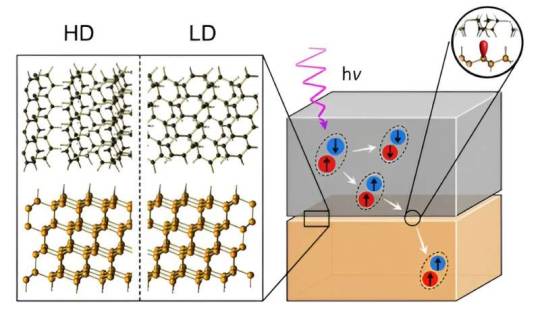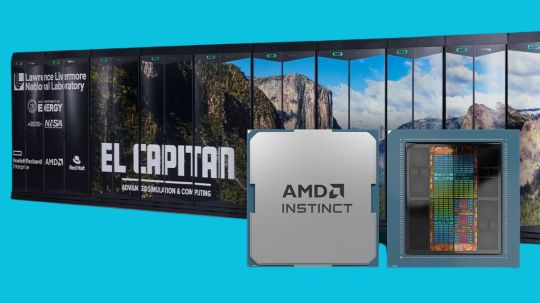#Paderborn University
Explore tagged Tumblr posts
Text

Physicists develop new solar cell design for better efficiency
Physicists at Paderborn University have used complex computer simulations to develop a new design for significantly more efficient solar cells than previously available. A thin layer of organic material, known as tetracene, is responsible for the increase in efficiency. The results have now been published in Physical Review Letters. "The annual energy of solar radiation on Earth amounts to over one trillion kilowatt hours and thus exceeds the global energy demand by more than 5,000 times. Photovoltaics, i.e., the generation of electricity from sunlight, therefore offers a large and still largely untapped potential for the supply of clean and renewable energy. Silicon solar cells used for this purpose currently dominate the market, but have efficiency limits," explains Prof Dr. Wolf Gero Schmidt, physicist and Dean of the Faculty of Natural Sciences at Paderborn University. One reason for this is that some of the energy from short-wave radiation is not converted into electricity, but into unwanted heat.
Read more.
#Materials Science#Science#Solar power#Organic materials#Paderborn University#Efficiency#Defects#Silicon
13 notes
·
View notes
Text


From time to time I discover largely forgotten artists and architects whose work immediately strikes me as original and which leaves me wondering why they aren’t better known. One such artist is Franz Pauli (1927-70), a painter and stained glass artist based in Cologne. In fact Pauli studied biology and art at the Cologne Werkkunstschule, the Düsseldorf Art Academy and Cologne University to become a teacher but never worked as one. Among his teachers were Otto Pankok in Düsseldorf and Friedrich Vordemberge-Gildewart in Cologne and especially the latter’s example of Constructivism had a lasting impact on Pauli: up until his untimely death Pauli refined his constructivist language towards a highly individual idiom characterized by distinctive sense of rhythm and order inspired by technical symbols and circuitry. This formal vocabulary he also applied in his manifold stained glass designs for churches in predominantly the Cologne, Paderborn and Essen dioceses.
The present little book, published alongside the artist‘s retrospective exhibition at Maternushaus Köln in 1988, contains a brief cross-section of Pauli‘s œuvre that includes stained glass works, graphics, paintings and gouaches. The latter are characterized by horizontal and vertical layers that sometimes even include figurative elements, a significant deviation from his other works. It seems that Pauli despite his largely constructivist art never completely abandoned figuration as it frequently appears in his stained glass works too. In spite of his early death the artist left a very interesting and diverse oeuvre that unfortunately is very much forgotten.
#franz pauli#constructivism#modern art#art book#art history#forgotten artist#book#exhibition catalogue
56 notes
·
View notes
Text
Making history with 42 digits, scientists at Paderborn University and KU Leuven have unlocked a decades-old mystery of mathematics with the so-called ninth Dedekind number. Experts worldwide have been searching for the value since 1991. The Paderborn scientists arrived at the exact sequence of numbers with the help of the Noctua supercomputer located there. The results will be presented in September at the International Workshop on Boolean Functions and their Applications (BFA) in Norway. What started as a master's thesis project by Lennart Van Hirtum, then a computer science student at KU Leuven and now a research associate at the University of Paderborn, has become a huge success. The scientists join an illustrious group with their work. Earlier numbers in the series were found by mathematician Richard Dedekind himself when he defined the problem in 1897, and later by greats of early computer science such as Randolph Church and Morgan Ward. "For 32 years, the calculation of D(9) was an open challenge, and it was questionable whether it would ever be possible to calculate this number at all," Van Hirtum says.
Continue Reading
101 notes
·
View notes
Text
Confs: Professionalizing the Teachers of Today and Tomorrow: Language Teacher Identity and Beyond
We are seeking proposals for a one-day symposium in November 2025 on (foreign) language teacher identity within various sociocultural, institutional, and policy-driven contexts. Language teacher identity (LTI) is a crucial aspect of teacher development and professionalization, which is dynamic and multifaceted in nature. This conference, which is held in-person and at Paderborn University, aims to explore the evolving nature of LTI, examining how educators construct, negotiate, and perform their http://dlvr.it/TK6KYm
0 notes
Text
Scientists at Paderborn University have developed high-performance computing (HPC) software to analyze quantum states of a photonic quantum detector. This software allows for quantum tomography, which determines the quantum state of a quantum system. The researchers were able to perform quantum tomography on a mega-scale quantum photonic detector using HPC, making calculations faster and more efficient. This work represents a significant advancement in applying classical HPC to experimental quantum photonics on a large scale and could lead to improvements in data processing and quantum technologies.
Source: https://interestingengineering.com/science/high-performance-computing-quantum-photonics-experiment
0 notes
Text
Accelerates AMD Exascale Leap of El Capitan Sixth in 2024

AMD Turbocharges El Capitan AMD Exascale Computing fastest supercomputer placed sixth in Supercomputing 2024.
Exascale Meaning
Exascale computing is a subset of supercomputing that is extremely powerful. Systems that use an infrastructure of CPUs and GPUs to handle and analyze data may execute billions of calculations per second.
The newest Top500 list states that the El Capitan supercomputer at Lawrence Livermore National Laboratory (LLNL), powered by AMD Instinct MI300A APUs and constructed by HPE, is the fastest supercomputer in the world with a High-Performance Linpack (HPL) score of 1.742 exa Oak Ridge National Lab’s Frontier system and El Capitan, which placed 18 and 22 on the Green500 list, showed AMD EPYC CPUs and AMD Instinct GPUs’ HPC performance and energy efficiency.
AMD Powering HPC and AI
The most significant supercomputers are still powered by AMD compute engines, which also provide outstanding technical computing performance to businesses and government labs worldwide.
With up to 37% greater generational IPC performance for HPC and AI applications, the most recent AMD EPYC 9005 Series processors are the finest server CPUs for business, AI, and cloud computing. In comparison to the competition, these processors offer up to 3.9X quicker time to insights for scientific and HPC applications that address the most difficult issues in the world.
From AI solutions to AMD Exascale-class supercomputers, AMD Instinct accelerators offer the data center’s best performance at any scale. AMD Instinct MI300X and MI325X accelerators provide improved AI performance and memory, while the MI300A APU combines CPU and GPU cores with stacked memory for HPC and AI applications.
AMD EPYC CPUs and AMD Instinct accelerators power several innovative AI and supercomputing initiatives, including:
Italian energy giant Eni introduced the HPC 6 supercomputer featuring AMD EPYC CPUs and Instinct GPUs. Powerful industrial supercomputer HPC 6 is sixth fastest worldwide. A new supercomputer with 5th Gen AMD EPYC CPUs is being delivered and installed at Paderborn University.
An HPE Cray Supercomputing EX system with 5th Gen AMD EPYC CPUs will be used by Sigma2 AS to replace two of Norway’s three state-owned supercomputers. This supercomputer is anticipated to be Norway’s fastest system once it is completely built. AMD and IBM have partnered to offer AMD Instinct MI300X accelerators on IBM Cloud as a service.
With the goal of improving performance and power efficiency for Gen AI models, such as high-performance computing applications for business clients, this solution is anticipated to become available in the first half of 2025. Additionally, the partnership will make it possible for Red Hat Enterprise Linux AI inferencing and AMD Instinct MI300X accelerators to be supported within IBM’s Watsonx AI and data platform.
Additionally, a next-generation supercomputer system for Japan’s National Institutes for Quantum Science and Technology (QST) will be powered by AMD Instinct MI300A APUs. The NEC Corporation-built system will power scientific and artificial intelligence research for the National Institutes for Fusion Science and Quantum Science and Technology using 280 AMD Instinct MI300A APUs.
Leading the AMD Exascale Era
AMD continues to lead HPC deployments globally in terms of performance and energy efficiency as the sole manufacturer powering many exascale supercomputers.
The NNSA Tri-Labs LLNL, Los Alamos, and Sandia National Laboratories rely on El Capitan, the most potent supercomputer in the world and the first exascale-class machine for the NNSA, as their primary computing resource. By offering the enormous processing capacity required to guarantee the safety, security, and dependability of the country’s nuclear deterrent without testing, it will be utilized to promote scientific research and national security.
This cutting-edge system represents a significant advancement in HPC, allowing for previously unheard-of modeling and simulation capabilities that are crucial for other vital nuclear security missions, including counterterrorism and nonproliferation, as well as NNSA’s Stockpile Stewardship Program, which certifies the aging nuclear stockpile.
In order to further advance LLNL’s AI-driven objectives of developing scientific models that are quick, precise, and able to quantify uncertainty in their predictions, LLNL and the other NNSA Tri-Labs are also utilizing El Capitan and its companion system, Tuolumne, to drive AI and machine learning-assisted data analysis. Tuolumne will be utilized for unclassified open scientific applications such as seismic modeling, biosecurity/drug discovery, and climate modeling, while El Capitan will apply AI to high energy density challenges like inertial confinement fusion research.
Beyond El Capitan, AMD and HPE power Frontier, the first AMD exascale supercomputer. Oak Ridge National Lab’s Frontier is the second-fastest computer in the world at 1.35 exaflops. AMD Instinct GPUsand EPYC CPUs power it. Frontier supports researchers in biomedical research, climate modeling, and large language model training, underlining its importance in scientific growth and AI advancements.
These cutting-edge systems offer enormous computing capacity that greatly advances a variety of fields of study, such as materials science, climate modeling, and the creation of AI models. By empowering researchers in many domains and supporting AI model development, El Capitan and Frontier are shaping science and technology and providing answers to global concerns. AMD is committed to offering high-performance computer resources to advance scientific research.
Read more on govindhtech.com
#AMDExascaleLeap#ElCapitanSixthin2024#AMDInstinctMI300A#AMDEPYC9005#AMDEPYCCPU#GenAImodels#machinelearning#AMDInstinctGPU#TECHNOLOGY#technews#news#govindhtech
0 notes
Link
0 notes
Text
Events 4.25 (before 1940)
404 BC – Admiral Lysander and King Pausanias of Sparta blockade Athens and bring the Peloponnesian War to a successful conclusion. 775 – The Battle of Bagrevand puts an end to an Armenian rebellion against the Abbasid Caliphate. Muslim control over the South Caucasus is solidified and its Islamization begins, while several major Armenian nakharar families lose power and their remnants flee to the Byzantine Empire. 799 – After mistreatment and disfigurement by the citizens of Rome, Pope Leo III flees to the Frankish court of king Charlemagne at Paderborn for protection. 1134 – The name Zagreb was mentioned for the first time in the Felician Charter relating to the establishment of the Zagreb Bishopric around 1094. 1607 – Eighty Years' War: The Dutch fleet destroys the anchored Spanish fleet at Gibraltar. 1644 – Transition from Ming to Qing: The Chongzhen Emperor, the last Emperor of Ming China, commits suicide during a peasant rebellion led by Li Zicheng. 1707 – A coalition of Britain, the Netherlands and Portugal is defeated by a Franco-Spanish army at Almansa (Spain) in the War of the Spanish Succession. 1792 – Highwayman Nicolas J. Pelletier becomes the first person executed by guillotine. 1792 – "La Marseillaise" (the French national anthem) is composed by Claude Joseph Rouget de Lisle. 1808 – Dano-Swedish War of 1808–1809: The Battle of Trangen took place at Trangen in Flisa, Hedemarkens Amt, between Swedish and Norwegian troops. 1829 – Charles Fremantle arrives in HMS Challenger off the coast of modern-day Western Australia prior to declaring the Swan River Colony for the British Empire. 1846 – Thornton Affair: Open conflict begins over the disputed border of Texas, triggering the Mexican–American War. 1849 – The Governor General of Canada, Lord Elgin, signs the Rebellion Losses Bill, outraging Montreal's English population and triggering the Montreal Riots. 1859 – British and French engineers break ground for the Suez Canal. 1862 – American Civil War: Forces under U.S. Admiral David Farragut demand the surrender of the Confederate city of New Orleans, Louisiana. 1864 – American Civil War: In the Battle of Marks' Mills, a force of 8,000 Confederate soldiers attacks 1,800 Union soldiers and a large number of wagon teamsters, killing or wounding 1,500 Union combatants. 1882 – French and Vietnamese troops clashed in Tonkin, when Commandant Henri Rivière seized the citadel of Hanoi with a small force of marine infantry. 1898 – Spanish–American War: The United States Congress declares that a state of war between the U.S. and Spain has existed since April 21, when an American naval blockade of the Spanish colony of Cuba began. 1901 – New York becomes the first U.S. state to require automobile license plates. 1915 – World War I: The Battle of Gallipoli begins: The invasion of the Turkish Gallipoli Peninsula by British, French, Indian, Newfoundland, Australian and New Zealand troops, begins with landings at Anzac Cove and Cape Helles. 1916 – Anzac Day is commemorated for the first time on the first anniversary of the landing at ANZAC Cove. 1920 – At the San Remo conference, the principal Allied Powers of World War I adopt a resolution to determine the allocation of Class "A" League of Nations mandates for administration of the former Ottoman-ruled lands of the Middle East. 1933 – Nazi Germany issues the Law Against Overcrowding in Schools and Universities limiting the number of Jewish students able to attend public schools and universities. 1938 – U.S. Supreme Court delivers its opinion in Erie Railroad Co. v. Tompkins and overturns a century of federal common law.
0 notes
Text
0 notes
Text
Ninth Dedekind number discovered: Scientists solve long-known problem in mathematics
0 notes
Text
Phys.org: Ninth Dedekind number discovered: Scientists solve long-known problem in mathematics
0 notes
Text
With custom firmware and some algorithmic tricks, computer scientists have completed a calculation that recently seemed impractical. I love stories like this!
#computer science#mathematics#calculation#supercomputer#big problem#monotone#algorithms#paderborn#like wow#fpga#parallelism
0 notes
Text
Confs: 23rd International Symposium of Processability Approaches to Language Acquisition
We are delighted to announce that the 23rd International Symposium of Processability Approaches to Language Acquisition (PALA) 2025 will be held in face-to-face mode at the Paderborn University, Germany, on the 18th and19th of September, 2025. The symposium focuses on research and developments related to processability approaches to language acquisition, particularly second language acquisition and bilingualism/ multilingualism research. We welcome submissions addressing theoretical con http://dlvr.it/TJldrJ
0 notes
Text
Scientists at Paderborn University in Germany have developed high-performance computing software that can analyze quantum states of a photonic quantum detector on a large scale. By using advanced classical computers, the researchers were able to carry out quantum tomography on a mega-scale quantum photonic detector, providing valuable insights for quantum research and technologies. The software optimizes the quantum tomography process, enabling faster and more efficient data processing. This groundbreaking work could lead to advancements in quantum measurement and communication technologies.
Source: https://interestingengineering.com/science/high-performance-computing-quantum-photonics-experiment
0 notes
Text
Quantum Photonics: Improving Future Of Light-Based Computing

Quantum Photonics is analyzed on high-performance computers initially. A secret relationship between quantum photonics and classical high-performance computing may surprise you.
High-performance computing (HPC) software has been created by researchers at Paderborn University in Germany to study and characterize the quantum states of a photonic quantum detector.
Using sophisticated classical computers to handle massive datasets, carry out intricate computations, and quickly resolve difficult issues is known as high-performance computing, or HPC.
What Is Quantum Photonics?
The study of producing, modifying, and detecting light in regimes where individual quanta of the light field (photons) may be coherently controlled is known as quantum photonics.
What Is The Use Of Photonics?
Light is transformed into electrical impulses using photonic sensors. The energy sector uses this technology extensively. The most prevalent applications of photonic sensing are solar power and wind, oil, and geothermal energy monitoring.
In the past, it has been essential to investigating quantum phenomena, such as the Bell test experiments and the EPR conundrum. Future technologies including quantum metrology, quantum computing, and quantum key distribution are also anticipated to be greatly advanced by quantum photonics.
Because of their minimal decoherence characteristics, light-speed transmission, and simplicity of manipulation, photons are especially appealing as carriers of quantum information. Traditionally, “bulk optics” technology individual optical components (beamsplitters, lenses, etc.) installed on a massive optical table with a total mass of hundreds of kilograms was used in quantum photonics studies.
Integrated Quantum Photonics
One crucial step in creating practical quantum technology is the use of integrated quantum photonic circuits to quantum photonics. Compared to bulk optics, single die photonic circuits have the following benefits:
Miniaturization: A smaller system size results in an order of magnitude reduction in size, weight, and power consumption.
Stability: Waveguides and other components made from miniature parts using sophisticated lithographic processes are naturally phase stable (coherent) and don’t need optical alignment.
Experiment size: A device that is just a few square centimeters in size may have a large number of optical components.
Manufacturability: Devices may be produced in huge quantities at a much reduced price. Products based on this technology can be produced using current manufacturing processes and procedures since the elements used in Integrated Quantum Photonics are more easily miniaturized due to their well-developed fabrication techniques.
Parts: There are several practical distinctions between quantum and conventional photonic integrated circuits, despite the fact that both employ the same basic components. In quantum photonics, loss is the most important component as single photon quantum states cannot be amplified (no-cloning theorem).
Applications Of Quantum Photonics
Waveguides, directional couplers, and phase shifters are the building elements used to construct single photon sources. Increased nonlinear interaction for photon pair generation is typically provided by optical ring resonators and long waveguide sections, but efforts are also underway to integrate solid state systems single Waveguide photonic circuits for quantum dot and nitrogen-vacancy center photon sources.
Many applications for quantum photonics include:
Quantum communication: It may improve information security via QKD and other methods. Eavesdropping can be stopped using the non-cloning theorem.
Quantum computing: Quantum photonics may encode information in quantum bits (qubits) for faster processing.
Quantum photonic allows quantum simulation.
Using quantum photonics, quantum metrology may be accomplished.
Photonics might enable quantum teleportation.
Random number generators: Random numbers may be produced via quantum photonics.
Quantum Photonics Advantages
The advantages of quantum photonics are many and include:
Scalability
Large quantities of photonic integrated circuits (PICs) may be produced on a wafer, which saves money and time.
Compactness
Unlike optical benches, PICs incorporate optical components into a centimeter-long chip. High degrees of control over light and the generation, modification, and detection of light are made possible by control PICs.
Compatibility
Current silicon chip production techniques and telecom light sources are compatible with photonics.
Adaptability to the environment
Without the need of complex cooling techniques, photon-based computers can function at ambient temperature.
Effective storage
Compared to conventional hardware, photonic quantum computers have a more efficient amount of area for information storage.
Networks of quantum systems
Photonic quantum processors may be used as servers for distributed quantum computing resources or as repeaters for quantum error correction.
Component Of Quantum Photonic
Photons are used in quantum photonics to create and preserve quantum states for quantum processes. Compared to other possibilities, photons are a sensitive medium that is less impacted by electromagnetic interference. Because they may be utilized to create small, scalable, and highly effective devices, photonic integrated circuits (PICs) are an essential component of quantum photonic systems.
Read more on Govindhtech.com
#Highperformancecomputing#QuantumPhotonics#datasets#quantumcomputing#quantumphotonicsystems#News#Technews#Technology#technologynews#technologytrends#govindhtech
0 notes
Photo

❗Call for Papers❗ Libori Summer School 2019: Teaching Women Philosophers The Call for Papers for the 3rd Libori Summer School is now open! For the third year in a row, the Libori Summer School will be held by the Center for the History of Women Philosophers and Scientists in Paderborn, Germany. This year’s summer school takes place from July 29th to August 2nd at Paderborn University. This conference provides a platform for experts to present and further their work on women philosophers in cooperation with peers. This opportunity for networking allows researchers to experience an inspiring community, and exchange ideas and experiences with regard to teaching women philosophers. "Teaching Women Philosophers” is the topic of the Libori Summer School 2019. This year, we will run two parallel Libori Summer Schools, one in English and one in German language. For further information, please visit https://historyofwomenphilosophers.org/libori-summer-school2019/. The morning workshops will be held by Sarah Hutton (University of York, UK), Sabrina Ebbersmeyer (University of Copenhagen, Germany/Denmark), Ronny Miron (Bar-Ilan University, Tel Aviv), Luka Borsic and Ivana Skuhala Karasman (University of Zagreb, Croatia), Antonio Calcagno (Kings College, London, Ontario, CA); our invited guests for the English section. The afternoon lectures provide a forum for presenting your papers. Please send us your proposal specifying which topic or about which philosopher you would like to teach or can provide teaching experience. What are the main ideas of your teaching concepts and to which texts does your concept refer? Conceptual comparisons in the history of philosophy are welcome, as well as papers that focus on the work of specific women philosophers. The time frame is – depending on the proposals submitted – between 30-90 minutes. You are free to choose an interactive style of presentation (workshop opposed to a classical talk). The Summer School`s program will be organized according to the proposed topics and will run in parallel sections. The best conference presentations have the chance to be published in the volume Teaching Women Philosophers (in the Springer book series Women in the History of Philosophy and Sciences, see https://www.springer.com/series/15896) making practicable advice and teaching material available within the community. • Deadline: May 5, 2019 • Between 500-2.000 words • Abstracts are to be submitted via e-mail to [email protected] Everyone is welcome to attend the Libori Summer School! A registration is required, the conference fee will be approx. 10€. https://historyofwomenphilosophers.org/libori-summer-school-2019/
#libori summer school#lisus2019#paderborn university#centerhwps#historyofwomenphilosophers#philosophy#womeninphilosophy#womenphilosophers#academia
1 note
·
View note